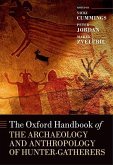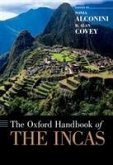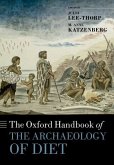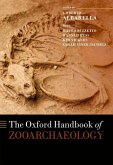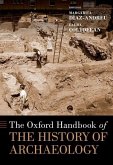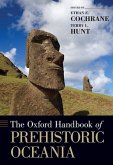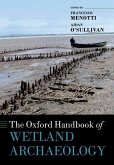- Gebundenes Buch
- Merkliste
- Auf die Merkliste
- Bewerten Bewerten
- Teilen
- Produkt teilen
- Produkterinnerung
- Produkterinnerung
This Handbook provides the first comprehensive overview of the rich archaeology of Mesolithic Europe. Chapters from leading scholars examine the period in different European regions, with thematic chapters on different kinds of landscape, different forms of technology, and aspects of Mesolithic life, death, ritual, cosmology, and art.
Andere Kunden interessierten sich auch für
![The Oxford Handbook of the Archaeology and Anthropology of Hunter-Gatherers The Oxford Handbook of the Archaeology and Anthropology of Hunter-Gatherers]() The Oxford Handbook of the Archaeology and Anthropology of Hunter-Gatherers317,99 €
The Oxford Handbook of the Archaeology and Anthropology of Hunter-Gatherers317,99 €![The Oxford Handbook of the Incas The Oxford Handbook of the Incas]() The Oxford Handbook of the Incas263,99 €
The Oxford Handbook of the Incas263,99 €![The Oxford Handbook of the Archaeology of Diet The Oxford Handbook of the Archaeology of Diet]() The Oxford Handbook of the Archaeology of Diet222,99 €
The Oxford Handbook of the Archaeology of Diet222,99 €![The Oxford Handbook of Zooarchaeology The Oxford Handbook of Zooarchaeology]() The Oxford Handbook of Zooarchaeology233,99 €
The Oxford Handbook of Zooarchaeology233,99 €![The Oxford Handbook of the History of Archaeology The Oxford Handbook of the History of Archaeology]() The Oxford Handbook of the History of Archaeology271,99 €
The Oxford Handbook of the History of Archaeology271,99 €![The Oxford Handbook of Prehistoric Oceania The Oxford Handbook of Prehistoric Oceania]() The Oxford Handbook of Prehistoric Oceania228,99 €
The Oxford Handbook of Prehistoric Oceania228,99 €![Oxford Handbook of Wetland Archaeology Oxford Handbook of Wetland Archaeology]() Oxford Handbook of Wetland Archaeology245,99 €
Oxford Handbook of Wetland Archaeology245,99 €-
-
-
This Handbook provides the first comprehensive overview of the rich archaeology of Mesolithic Europe. Chapters from leading scholars examine the period in different European regions, with thematic chapters on different kinds of landscape, different forms of technology, and aspects of Mesolithic life, death, ritual, cosmology, and art.
Hinweis: Dieser Artikel kann nur an eine deutsche Lieferadresse ausgeliefert werden.
Hinweis: Dieser Artikel kann nur an eine deutsche Lieferadresse ausgeliefert werden.
Produktdetails
- Produktdetails
- Verlag: Oxford University Press
- Seitenzahl: 1024
- Erscheinungstermin: 24. Januar 2025
- Englisch
- ISBN-13: 9780198853657
- ISBN-10: 0198853653
- Artikelnr.: 71265227
- Herstellerkennzeichnung
- Libri GmbH
- Europaallee 1
- 36244 Bad Hersfeld
- 06621 890
- Verlag: Oxford University Press
- Seitenzahl: 1024
- Erscheinungstermin: 24. Januar 2025
- Englisch
- ISBN-13: 9780198853657
- ISBN-10: 0198853653
- Artikelnr.: 71265227
- Herstellerkennzeichnung
- Libri GmbH
- Europaallee 1
- 36244 Bad Hersfeld
- 06621 890
Liv Nilsson Stutz is Professor of Archaeology at Linnaeus University and has a background in archaeology and biological anthropology. She is a specialist in burial archaeology with a particular focus on archeothanatology, ritual practice, ritual theory, and body theory, which she has applied in a reinterpretation of Mesolithic mortuary practices with case studies in Scandinavia, the Eastern Baltic, and Portugal. Her work also engages concepts of hunter gatherer cosmology and ontology. She has published broadly on the archaeology of death, archaeological method and theory, ritual theory, and on issues of research ethics. Rita Peyroteo Stjerna is a Researcher at the Department of Organismal Biology, Upssala University. She is a bioarchaeologist specializing in mortuary archaeology.She is trained in archaeothanatology, ancient DNA, radiocarbon, and stable isotopes. She thrives in interdisciplinary environments and has been working with archaeological human remains in museums in Europe, Africa, and Southeast Asia. She holds a PhD in archaeology from Uppsala University, focusing on the role of mortuary ritual practice in Mesolithic hunter-gatherers, and she has published on Holocene hunter-gatherers in Western Europe integrating multiple disciplines. Her main interests are mortuary archaeology, archaeological science, and ethical issues concerning the biomolecular research of ancient human remains. Mari Tõrv is Associate Professor in Archaeology at the Institute of History and Archaeology, University of Tartu. She is an archaeologist with a multi-disciplinary background in archaeology, human osteology, archaeothanatology, stable isotope studies, and ritual studies. Her research interests are wide, extending from hunter-gatherer mortuary practices and identities to the genetic history of Nordic and Eastern European populations together with life and death ways of early farmers and first Christians. Currently, her work bridges archaeology and chemistry to reconstruct past food ways and explore the research potential of archaeological human remains in general. Her work involves the application of the state-of-the-art methods in stable isotope studies and their combination with other biomolecular analysis to form narratives about past lifestyles.
* Part I: MESOLITHIC EUROPE * 1: Liv Nilsson Stutz, Rita Peyrotero Stjerna, and Mari Tõrv: Introduction: The Archaeology of Mesolithic Europe * 2: Graeme Warren: The Mesolithic: What is it and Why Should We Care? * 3: Philippe Crombé: Early and Middle Holocene Climate and Environmental Change * 4: Rick J. Schulting and Christopher Meiklejohn: Time Matters: Chronology in the European Mesolithic * 5: Peter Rowley-Conwy: Mesolithic Landscapes and Niche Construction: A Great Capability for Misunderstanding * Part II: MESOLITHIC GEOGRAPHIES * 6: Ekaterina Dolbunova and Andrey Mazurkevich: Eastern Europe * 7: Daniel Groß and Tomas Rimkus: The Baltic Basin: Northern Germany to the Baltic States * 8: Kjel Knutsson: Northern Scandinavia * 9: T. Douglas Price: Southern Scandinavia * 10: James Walker, Vince Gaffney, Simon Fitch, and Andy Fraser: Doggerland * 11: Catriona Pickard and Clive Bonsall: Britain and Ireland * 12: Witold Grüd
, Daniel Groß, Katarzyna Py
ewicz, and Aliaksandr Vashanau: Continental European Plain * 13: Paolo Biagi: The Black Sea Area * 14: Ana Cristina Araújo and Grégor Marchand
: The Atlantic Coast (Western France, Northern Spain and Portugal) * 15: Hans Vandendriessche, Colas Guéret, Benjamin Marquebielle, and Philippe Crombé: Continental France and the Benelux * 16: Federica Fontana: Alpine Region (Switzerland, Austria, Slovenia, and Northern Italy) * 17: Thomas Perrin: The Western Mediterranean Coast and Islands (Spain, Balearic Islands, Corsica, Sardinia, France, Italy, Sicily, and North Africa) * 18: Nena Galanidou, Nikola Vukosavljevi
, and Catherine Perlès: The Eastern Mediterranean * 19: Clive Bonsall, Adina Boronean
, and Monica M
rg
rit: Southeast Europe (The Balkans and the Danube) * 20: Aaron Jonas Stutz: The Natufian Archaeological Culture in Southwestern Asian Epipalaeolithic Context * Part III: HUNTER-GATHERER LANDSCAPES * 21: Hein B. Bjerck: Sea * 22: Ivana ivaljevi
: Rivers * 23: Ingrid Fuglestvedt: The Pioneer Experience: A Perspective from the Early Mesolithic Site Complex at Pauler, Eastern Norway * 24: Davide Visentin: Mountains and High Altitudes * 25: Catherine Dupont and Igor Gutiérrez-Zugasti: Shell Middens and Shells * 26: Barry Taylor: Wetland Landscapes * 27: Alexander Verpoorte and Fulco Scherjon: Inland/Forest * Part IV: MESOLITHIC LIFE * 28: Luciana G. Simões and Torsten Günther: Who Were the Mesolithic People: The Archaeogenomic Perspective * 29: Daniela Holst: Hunter-Gatherer Mobility and Sedentism * 30: Solange Rigaud and Aimée Little: Identity, Gender, and Power: Life Histories of Personal Ornaments, Stone Tools, and Other Artefacts * 31: Aaron Jonas Stutz: Demography, Life Histories, and Population Dynamics * 32: Jörg Orschiedt: Violence * 33: Ben Elliot: Sensory Experiences * 34: Gunilla Eriksson and Kerstin Lidén: Food and Diet: A Châine Opératoire Perspective on Hunter-Gatherer Food Practice * 35: Mariana Diniz: Coexistence with Neolithic Neighbours * 36: Barry Taylor and Nick J. Overton: Relationships with the Environment: Plants and Animals * Part V: MEANINGFUL TECHNOLOGY * 37: Ole Grøn: Shelter and Dwellings * 38: Nick J. Overton: Hunting * 39: Harry K. Robson, Adam Boethius, and Kenneth Ritchie: Fishing * 40: Lucy Kubiak-Martens: The Plant Food Diet of Mesolithic Northwestern Europe * 41: Ekaterina Kashina: Art and Symbolism: The Forms and Meanings of the Portable Art of the East European Plain Hunter-Gatherer-Fishers * 42: Miriam Cubas and Harry K. Robson: Pottery Production among European Foragers * 43: Mikkel Sørensen: Lithic Technology * 44: Eva David: Bone Tool Technology * 45: Astrid J. Nyland: Quarrying and Lithic Procurement * 46: Kurt J. Gron: Animal Domestication in the Mesolithic * 47: Kristiina Johanson, Dagmara H. Werra, Aivar Kriiska, and Javier Mangado Llach: Flint Exchange * 48: Aija Macane and Kerkko Nordqvist: Exchange of Amber * 49: Andrew Langley and Aimée Little: Birch, Pine, and Other Adhesive Technologies * Part VI: DEATH AND THE DEAD * 50: Amy Gray Jones: Human Remains in Non-Burial Contexts * 51: Mari Torv and Rita Peyroteo Stjerna: From the Treatment of the Body to the Places of the Dead * 52: Rock Images of the Dead: Glimpses of Past Mortuary Processes or Pictures of a Plaguea * 53: Liv Nilsson Stutz: The Handling of the Dead Body: Transformations from Life to Death * Part VII: COSMOLOGIES, RITUAL, AND SYMBOLISM * 54: Charlotte Damm: Forager Cosmologies in Northernmost Europe * 55: Kristiina Mannermaa: Human-Animal Relationships * 56: Chantal Conneller and Ben Elliott: Metamorphosis * 57: Tomasz P
onka: Sculpture and Art (Portable and Non-Portable) * 58: Antti Lahelma and Jan Magne Gjerde: Rock Art * 59: Mathias Bjørnevad-Ahlqvist: Hoarding
, Daniel Groß, Katarzyna Py
ewicz, and Aliaksandr Vashanau: Continental European Plain * 13: Paolo Biagi: The Black Sea Area * 14: Ana Cristina Araújo and Grégor Marchand
: The Atlantic Coast (Western France, Northern Spain and Portugal) * 15: Hans Vandendriessche, Colas Guéret, Benjamin Marquebielle, and Philippe Crombé: Continental France and the Benelux * 16: Federica Fontana: Alpine Region (Switzerland, Austria, Slovenia, and Northern Italy) * 17: Thomas Perrin: The Western Mediterranean Coast and Islands (Spain, Balearic Islands, Corsica, Sardinia, France, Italy, Sicily, and North Africa) * 18: Nena Galanidou, Nikola Vukosavljevi
, and Catherine Perlès: The Eastern Mediterranean * 19: Clive Bonsall, Adina Boronean
, and Monica M
rg
rit: Southeast Europe (The Balkans and the Danube) * 20: Aaron Jonas Stutz: The Natufian Archaeological Culture in Southwestern Asian Epipalaeolithic Context * Part III: HUNTER-GATHERER LANDSCAPES * 21: Hein B. Bjerck: Sea * 22: Ivana ivaljevi
: Rivers * 23: Ingrid Fuglestvedt: The Pioneer Experience: A Perspective from the Early Mesolithic Site Complex at Pauler, Eastern Norway * 24: Davide Visentin: Mountains and High Altitudes * 25: Catherine Dupont and Igor Gutiérrez-Zugasti: Shell Middens and Shells * 26: Barry Taylor: Wetland Landscapes * 27: Alexander Verpoorte and Fulco Scherjon: Inland/Forest * Part IV: MESOLITHIC LIFE * 28: Luciana G. Simões and Torsten Günther: Who Were the Mesolithic People: The Archaeogenomic Perspective * 29: Daniela Holst: Hunter-Gatherer Mobility and Sedentism * 30: Solange Rigaud and Aimée Little: Identity, Gender, and Power: Life Histories of Personal Ornaments, Stone Tools, and Other Artefacts * 31: Aaron Jonas Stutz: Demography, Life Histories, and Population Dynamics * 32: Jörg Orschiedt: Violence * 33: Ben Elliot: Sensory Experiences * 34: Gunilla Eriksson and Kerstin Lidén: Food and Diet: A Châine Opératoire Perspective on Hunter-Gatherer Food Practice * 35: Mariana Diniz: Coexistence with Neolithic Neighbours * 36: Barry Taylor and Nick J. Overton: Relationships with the Environment: Plants and Animals * Part V: MEANINGFUL TECHNOLOGY * 37: Ole Grøn: Shelter and Dwellings * 38: Nick J. Overton: Hunting * 39: Harry K. Robson, Adam Boethius, and Kenneth Ritchie: Fishing * 40: Lucy Kubiak-Martens: The Plant Food Diet of Mesolithic Northwestern Europe * 41: Ekaterina Kashina: Art and Symbolism: The Forms and Meanings of the Portable Art of the East European Plain Hunter-Gatherer-Fishers * 42: Miriam Cubas and Harry K. Robson: Pottery Production among European Foragers * 43: Mikkel Sørensen: Lithic Technology * 44: Eva David: Bone Tool Technology * 45: Astrid J. Nyland: Quarrying and Lithic Procurement * 46: Kurt J. Gron: Animal Domestication in the Mesolithic * 47: Kristiina Johanson, Dagmara H. Werra, Aivar Kriiska, and Javier Mangado Llach: Flint Exchange * 48: Aija Macane and Kerkko Nordqvist: Exchange of Amber * 49: Andrew Langley and Aimée Little: Birch, Pine, and Other Adhesive Technologies * Part VI: DEATH AND THE DEAD * 50: Amy Gray Jones: Human Remains in Non-Burial Contexts * 51: Mari Torv and Rita Peyroteo Stjerna: From the Treatment of the Body to the Places of the Dead * 52: Rock Images of the Dead: Glimpses of Past Mortuary Processes or Pictures of a Plaguea * 53: Liv Nilsson Stutz: The Handling of the Dead Body: Transformations from Life to Death * Part VII: COSMOLOGIES, RITUAL, AND SYMBOLISM * 54: Charlotte Damm: Forager Cosmologies in Northernmost Europe * 55: Kristiina Mannermaa: Human-Animal Relationships * 56: Chantal Conneller and Ben Elliott: Metamorphosis * 57: Tomasz P
onka: Sculpture and Art (Portable and Non-Portable) * 58: Antti Lahelma and Jan Magne Gjerde: Rock Art * 59: Mathias Bjørnevad-Ahlqvist: Hoarding
* Part I: MESOLITHIC EUROPE * 1: Liv Nilsson Stutz, Rita Peyrotero Stjerna, and Mari Tõrv: Introduction: The Archaeology of Mesolithic Europe * 2: Graeme Warren: The Mesolithic: What is it and Why Should We Care? * 3: Philippe Crombé: Early and Middle Holocene Climate and Environmental Change * 4: Rick J. Schulting and Christopher Meiklejohn: Time Matters: Chronology in the European Mesolithic * 5: Peter Rowley-Conwy: Mesolithic Landscapes and Niche Construction: A Great Capability for Misunderstanding * Part II: MESOLITHIC GEOGRAPHIES * 6: Ekaterina Dolbunova and Andrey Mazurkevich: Eastern Europe * 7: Daniel Groß and Tomas Rimkus: The Baltic Basin: Northern Germany to the Baltic States * 8: Kjel Knutsson: Northern Scandinavia * 9: T. Douglas Price: Southern Scandinavia * 10: James Walker, Vince Gaffney, Simon Fitch, and Andy Fraser: Doggerland * 11: Catriona Pickard and Clive Bonsall: Britain and Ireland * 12: Witold Grüd
, Daniel Groß, Katarzyna Py
ewicz, and Aliaksandr Vashanau: Continental European Plain * 13: Paolo Biagi: The Black Sea Area * 14: Ana Cristina Araújo and Grégor Marchand
: The Atlantic Coast (Western France, Northern Spain and Portugal) * 15: Hans Vandendriessche, Colas Guéret, Benjamin Marquebielle, and Philippe Crombé: Continental France and the Benelux * 16: Federica Fontana: Alpine Region (Switzerland, Austria, Slovenia, and Northern Italy) * 17: Thomas Perrin: The Western Mediterranean Coast and Islands (Spain, Balearic Islands, Corsica, Sardinia, France, Italy, Sicily, and North Africa) * 18: Nena Galanidou, Nikola Vukosavljevi
, and Catherine Perlès: The Eastern Mediterranean * 19: Clive Bonsall, Adina Boronean
, and Monica M
rg
rit: Southeast Europe (The Balkans and the Danube) * 20: Aaron Jonas Stutz: The Natufian Archaeological Culture in Southwestern Asian Epipalaeolithic Context * Part III: HUNTER-GATHERER LANDSCAPES * 21: Hein B. Bjerck: Sea * 22: Ivana ivaljevi
: Rivers * 23: Ingrid Fuglestvedt: The Pioneer Experience: A Perspective from the Early Mesolithic Site Complex at Pauler, Eastern Norway * 24: Davide Visentin: Mountains and High Altitudes * 25: Catherine Dupont and Igor Gutiérrez-Zugasti: Shell Middens and Shells * 26: Barry Taylor: Wetland Landscapes * 27: Alexander Verpoorte and Fulco Scherjon: Inland/Forest * Part IV: MESOLITHIC LIFE * 28: Luciana G. Simões and Torsten Günther: Who Were the Mesolithic People: The Archaeogenomic Perspective * 29: Daniela Holst: Hunter-Gatherer Mobility and Sedentism * 30: Solange Rigaud and Aimée Little: Identity, Gender, and Power: Life Histories of Personal Ornaments, Stone Tools, and Other Artefacts * 31: Aaron Jonas Stutz: Demography, Life Histories, and Population Dynamics * 32: Jörg Orschiedt: Violence * 33: Ben Elliot: Sensory Experiences * 34: Gunilla Eriksson and Kerstin Lidén: Food and Diet: A Châine Opératoire Perspective on Hunter-Gatherer Food Practice * 35: Mariana Diniz: Coexistence with Neolithic Neighbours * 36: Barry Taylor and Nick J. Overton: Relationships with the Environment: Plants and Animals * Part V: MEANINGFUL TECHNOLOGY * 37: Ole Grøn: Shelter and Dwellings * 38: Nick J. Overton: Hunting * 39: Harry K. Robson, Adam Boethius, and Kenneth Ritchie: Fishing * 40: Lucy Kubiak-Martens: The Plant Food Diet of Mesolithic Northwestern Europe * 41: Ekaterina Kashina: Art and Symbolism: The Forms and Meanings of the Portable Art of the East European Plain Hunter-Gatherer-Fishers * 42: Miriam Cubas and Harry K. Robson: Pottery Production among European Foragers * 43: Mikkel Sørensen: Lithic Technology * 44: Eva David: Bone Tool Technology * 45: Astrid J. Nyland: Quarrying and Lithic Procurement * 46: Kurt J. Gron: Animal Domestication in the Mesolithic * 47: Kristiina Johanson, Dagmara H. Werra, Aivar Kriiska, and Javier Mangado Llach: Flint Exchange * 48: Aija Macane and Kerkko Nordqvist: Exchange of Amber * 49: Andrew Langley and Aimée Little: Birch, Pine, and Other Adhesive Technologies * Part VI: DEATH AND THE DEAD * 50: Amy Gray Jones: Human Remains in Non-Burial Contexts * 51: Mari Torv and Rita Peyroteo Stjerna: From the Treatment of the Body to the Places of the Dead * 52: Rock Images of the Dead: Glimpses of Past Mortuary Processes or Pictures of a Plaguea * 53: Liv Nilsson Stutz: The Handling of the Dead Body: Transformations from Life to Death * Part VII: COSMOLOGIES, RITUAL, AND SYMBOLISM * 54: Charlotte Damm: Forager Cosmologies in Northernmost Europe * 55: Kristiina Mannermaa: Human-Animal Relationships * 56: Chantal Conneller and Ben Elliott: Metamorphosis * 57: Tomasz P
onka: Sculpture and Art (Portable and Non-Portable) * 58: Antti Lahelma and Jan Magne Gjerde: Rock Art * 59: Mathias Bjørnevad-Ahlqvist: Hoarding
, Daniel Groß, Katarzyna Py
ewicz, and Aliaksandr Vashanau: Continental European Plain * 13: Paolo Biagi: The Black Sea Area * 14: Ana Cristina Araújo and Grégor Marchand
: The Atlantic Coast (Western France, Northern Spain and Portugal) * 15: Hans Vandendriessche, Colas Guéret, Benjamin Marquebielle, and Philippe Crombé: Continental France and the Benelux * 16: Federica Fontana: Alpine Region (Switzerland, Austria, Slovenia, and Northern Italy) * 17: Thomas Perrin: The Western Mediterranean Coast and Islands (Spain, Balearic Islands, Corsica, Sardinia, France, Italy, Sicily, and North Africa) * 18: Nena Galanidou, Nikola Vukosavljevi
, and Catherine Perlès: The Eastern Mediterranean * 19: Clive Bonsall, Adina Boronean
, and Monica M
rg
rit: Southeast Europe (The Balkans and the Danube) * 20: Aaron Jonas Stutz: The Natufian Archaeological Culture in Southwestern Asian Epipalaeolithic Context * Part III: HUNTER-GATHERER LANDSCAPES * 21: Hein B. Bjerck: Sea * 22: Ivana ivaljevi
: Rivers * 23: Ingrid Fuglestvedt: The Pioneer Experience: A Perspective from the Early Mesolithic Site Complex at Pauler, Eastern Norway * 24: Davide Visentin: Mountains and High Altitudes * 25: Catherine Dupont and Igor Gutiérrez-Zugasti: Shell Middens and Shells * 26: Barry Taylor: Wetland Landscapes * 27: Alexander Verpoorte and Fulco Scherjon: Inland/Forest * Part IV: MESOLITHIC LIFE * 28: Luciana G. Simões and Torsten Günther: Who Were the Mesolithic People: The Archaeogenomic Perspective * 29: Daniela Holst: Hunter-Gatherer Mobility and Sedentism * 30: Solange Rigaud and Aimée Little: Identity, Gender, and Power: Life Histories of Personal Ornaments, Stone Tools, and Other Artefacts * 31: Aaron Jonas Stutz: Demography, Life Histories, and Population Dynamics * 32: Jörg Orschiedt: Violence * 33: Ben Elliot: Sensory Experiences * 34: Gunilla Eriksson and Kerstin Lidén: Food and Diet: A Châine Opératoire Perspective on Hunter-Gatherer Food Practice * 35: Mariana Diniz: Coexistence with Neolithic Neighbours * 36: Barry Taylor and Nick J. Overton: Relationships with the Environment: Plants and Animals * Part V: MEANINGFUL TECHNOLOGY * 37: Ole Grøn: Shelter and Dwellings * 38: Nick J. Overton: Hunting * 39: Harry K. Robson, Adam Boethius, and Kenneth Ritchie: Fishing * 40: Lucy Kubiak-Martens: The Plant Food Diet of Mesolithic Northwestern Europe * 41: Ekaterina Kashina: Art and Symbolism: The Forms and Meanings of the Portable Art of the East European Plain Hunter-Gatherer-Fishers * 42: Miriam Cubas and Harry K. Robson: Pottery Production among European Foragers * 43: Mikkel Sørensen: Lithic Technology * 44: Eva David: Bone Tool Technology * 45: Astrid J. Nyland: Quarrying and Lithic Procurement * 46: Kurt J. Gron: Animal Domestication in the Mesolithic * 47: Kristiina Johanson, Dagmara H. Werra, Aivar Kriiska, and Javier Mangado Llach: Flint Exchange * 48: Aija Macane and Kerkko Nordqvist: Exchange of Amber * 49: Andrew Langley and Aimée Little: Birch, Pine, and Other Adhesive Technologies * Part VI: DEATH AND THE DEAD * 50: Amy Gray Jones: Human Remains in Non-Burial Contexts * 51: Mari Torv and Rita Peyroteo Stjerna: From the Treatment of the Body to the Places of the Dead * 52: Rock Images of the Dead: Glimpses of Past Mortuary Processes or Pictures of a Plaguea * 53: Liv Nilsson Stutz: The Handling of the Dead Body: Transformations from Life to Death * Part VII: COSMOLOGIES, RITUAL, AND SYMBOLISM * 54: Charlotte Damm: Forager Cosmologies in Northernmost Europe * 55: Kristiina Mannermaa: Human-Animal Relationships * 56: Chantal Conneller and Ben Elliott: Metamorphosis * 57: Tomasz P
onka: Sculpture and Art (Portable and Non-Portable) * 58: Antti Lahelma and Jan Magne Gjerde: Rock Art * 59: Mathias Bjørnevad-Ahlqvist: Hoarding


